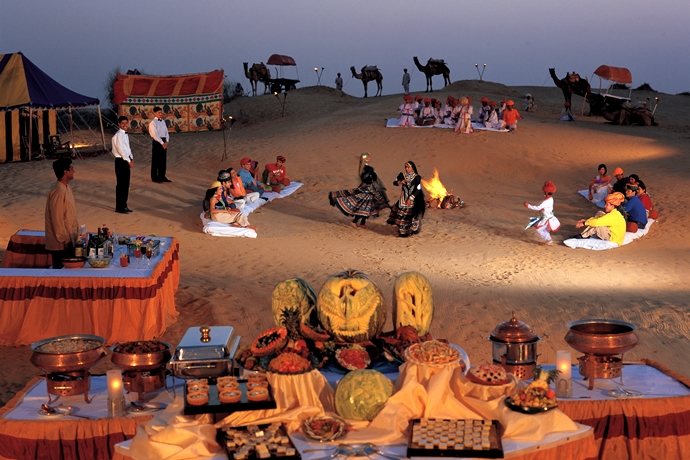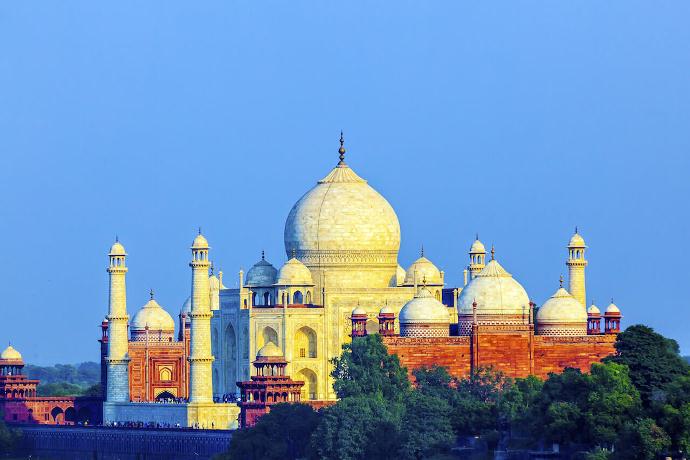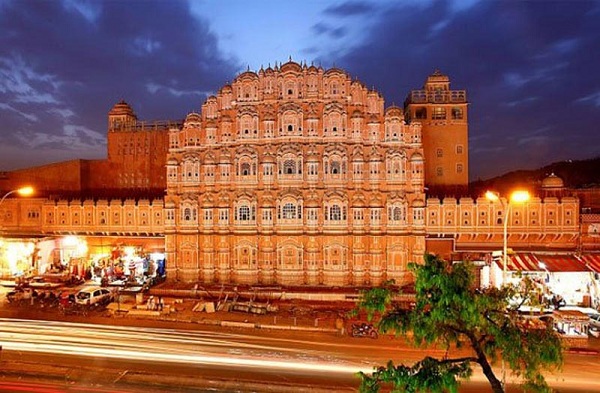
RAJASTHAN- The state of Rajasthan is associated with the astounding legends of heroism and romance still echoes from its royal fort and palaces that stands majestically on hilltop to narrate the tale of a chivalry and audacity. The magic of vibrant Rajasthan - its rich heritage, colorful culture, exciting desert safaris, shining sand-dunes, amazing variety lush forests and varied wildlife - makes it a destination nonpareil. Rajasthan is often portrayed as one vast open-air museum, with its relics so well preserved that it delights even the most skeptical traveler. Rajasthan India comprises of forts and palaces, wildlife's. All this makes Rajasthan a wonderful destination to explore. Travel Rajasthan in order to explore the exquisite craftsmanship of bygone era. Tourism in Rajasthan makes state one of the most visited state of India.
JODHPUR- Popularly called the Blue City of Rajasthan; Jodhpur is second largest city in Rajasthan after Jaipur. It is an island of marble palaces from the desert by an immense wall, with eight gates facing different directions. Jodhpur is famous for its magnificent fort and palaces. The city is situated at the edge of the Thar Desert with Jaisalmer on its west, Bikaner on its north side.
JAISALMER- Popularly known as the Desert City of Rajasthan, and is a paradise of the desert kingdom. It sets a image of deserted land with camel swiftly moving on the golden sands. The city is almost enticing and for domestic travelers as it is to foreign tourists. Standing in pride with its colossal forts, palaces and havelis, Jaisalmer showcases the artistic sense of the Rajput kings.
BIKANER- Located in the north western part of the state, Bikaner has a rich historical tradition and thousands of tourists from all over the year come here to get a feel of the rich tradition and culture. Bikaner attracts thousands of travelers for its rich historical tradition and culture. The city consists of beautiful forts, castles, religious shrines and other historical monuments.
MANDAWA- Mandawa is a small town in the heart of Shekhawati region. The place is known not only for its havelis but also for its Fort Palace. The structure of the palace reminds of the cultural and social importance of this region in the past. Of the havelis, the most important are the Chokhani, Ladia, Binsidhar Newatia, and Gulab Rai Ladia Haveli.
JAIPUR- Jaipur is remarkable for its marvelous architecture and town planning as it is for the lively spirit of the people who inhabit it. The city presents a unique synthesis of culture that has to be experienced in order to be appreciated. The old Jaipur painted in Pink, the lively spirit of fanfare, festivity and celebration of the people adequately match the colorful and intricately carved monuments.
FATEHPUR SIKRI- Once the capital of the Mughal emperor Akbar, a deserted, red sandstone city built by the Mughal Emperor Akbar in the 16th century. It is built in red sandstone, and is a beautiful blend of Hindu and Islamic architectural elements.
AGRA- The Land of culture and heritage. Agra is the city of the inimitable Taj Mahal. Agra is famous for its marble inlay work, leather goods, brass wares, finely worked precious and semi-precious stone jewellery and ornate zari embroidery.
DELHI- New Delhi, capital of India is a mix of the ancient and modern architecture. This 3rd largest city of India unwinds a picture rich with culture, architecture, and human diversity. Divided in two parts, Old Delhi & New Delhi, the city is a travel hub of Northern India and exerts a beguiling charm on visitors.
Tour Destination: Jodhpur - Jaisalmer - Bikaner - Mandawa - Jaipur - Agra - Delhi
Travel Duration: 8 nights/9 days
DAY 1: JODHPUR
Arrive in Jodhpur. Transfer to hotel, and after freshen up, enjoy full day city tour of The Blue City of Rajasthan- Jodhpur
UMAID BHAWAN PALACE- Maharaja Umaid Singh, a perfect example of early modern period architecture, constructed Umaid Bhawan Palace. Umaid Bhawan palace forms the grandest private royal houses of the world. Some portion of this grand palace has been converted into a luxurious hotel and a museum.
JASWANT THADA- It lies quite close to the Mehrangarh Fort complex. It was built in 1899 AD in the memory of Maharaja Jaswant Singh II and houses the cenotaphs of a number of Rajput royals. The main cenotaph has rare portraits of many Rajput rulers on display.
ARCHITECTURAL SPLENDOR OF JODHPUR- Given the rough terrain it is not surprising that the architecture of the city was influenced by it. Desert architecture is noted for two distinct traits, the need to guard against the heat and to fortify itself against invasions. Fortifications tend to merge with the color of the land, providing it with a natural camouflage.
THE MEHRANGARH FORT- Fort at Jodhpur is such that the fort walls and the sheer basalt escarpment are not distinguishable, one from the other. Huge gates at the entrance are fitted with iron nails to prevent elephants from bringing them down. The palaces and the mansions within the complex are more delicately designed. The chief palaces you can see in the fort are the Phool Mahal, the Moti Mahal, the Jhanki Mahal, the Sheesh Mahal and the Sadar Vilas.
Overnight at Hotel.
DAY 2: JODHPUR - JAISALMER
Today continue your drive to the desert town of Jaisalmer. Transfer to hotel and in the evening visit
SAM SAND DUNES- Sam Sand dunes are the major attractions of Jaislamer. It is 3 kms long and 1 km wide and is half a kilometer high. The Sam sand dunes are unreliable and they are picturesque. Sam Sand dunes are just the place to surf the golden sands of Rajasthan through a safari.
Overnight at Hotel.
DAY 3: JAISALMER
Take on a full day city tour of Jaisalmer.
JAISALMER FORT- This fort is the second oldest fort of Rajasthan. A sight to behold, this living fort is one of the marvels of Rajasthani Architecture, especially of the stone carver's art.
HAVELIES- Evoking a vision of chivalry and valor, wealthy merchants built these havelies. Famous for their intricately- carved facades, the workmanship of Jaisalmer's Havelies present a beautiful amalgam of Rajput architecture and Islamic art. Some of the famous havelies of Jaisalmer are Salim-Singh-ki-Haveli, Patwon-ki-Haveli, and Nathmal-ki-Haveli.
GADISSAR LAKE- The origin of this artificial water tank dates back to 1156 AD. Surrounded by small temples and shrines, it also gives a view of the exquisite archway, Teelon ki Pol - one of the main entrances to the lake and the city.
Overnight at Hotel.
DAY 4: JAISALMER - BIKANER
Next morning drive to the imposing walled city of Bikaner; transfer to hotel and after lunch visit Bikaner.
JUNAGARH FORT- The fort is lavishly carved with stone corridors, pavilions, stunning royal quarters, minarets, archways and ornamented courtyards. Raja Rai Singh, a general in Emperor Akbar's army built the Junagarh Fort.
LALGARH PALACE- The spectacular Palace is an outstanding architectural marvel that enchants you with a magical fusion Rajputana, European and Mughal building styles. Stone crafted pillars, Italian colonnades, spacious lounges, regal halls and profusely carved fire places at the imposing Lalgarh Palace in Bikaner transport you back in time to an incomparably lavish royal era.
GAJNER PALACE- This red sandstone Palace lies ensconced in the midst of wooded grounds and is a delightful palatial home that has been converted into a heritage hotel. Delicately carved columns, sculpted pillars and Jharokha windows add to the quiet class of this heritage palace in Bikaner, Rajasthan. Set on the banks of a serene lake the Gajner Palace is a glittering jewel on the Bikaner crown.
SHIV BARI TEMPLE- Constructed by Maharaja Doongar Singhji, the Shiv Bari Temple India is a virtual museum of miniature paintings that are delicate yet colorful representations of ethnic Bikaner traditions and patterns.
CAMEL BREEDING FARM- Popularly referred to as the Government Camel Breeding Farm, the National Research Center on Camel breeds the best camels in Bikaner and conducts research work related to "the ship of the desert.
Overnight at Hotel.
DAY 5: BIKANER - MANDAWA
Next morning drive towards a small town in the heart of Shekhawati Region- Mandawa. Transfer to hotel. In the evening visit
HAVELIS- The most important are the Chokhani, Ladia, Binsidhar Newatia known for its curious paintings, and Gulab Rai Ladia Haveli famous for erotic images now mostly defaced.
FORT PALACE- The structure of the palace reminds of the cultural and social importance of this region in the past.
Overnight at Hotel.
DAY 6: MANDAWA - JAIPUR
Today, drive towards Jaipur- the pristine jewel in the desert sands of Rajasthan. Transfer to hotel and evening time to relax.
Overnight at Hotel.
DAY 7: JAIPUR
After breakfast visit the Pink City viewing
HAWA MAHAL- One of the most common and popular tourist attractions in Jaipur. This five-storey building was used as a veil by the royal women folk to watch the proceedings on the road below.
CITY PALACE- In the heart of the old city is former royal residence built in a blend of the Rajasthani and Mughal styles. The palace also has an art gallery with an excellent collection of miniature paintings, carpets, royal paraphernalia and rare astronomical works in Arabic, Persian, Latin and Sanskrit, acquired by Sawai Jai Singh II to study astronomy in detail.
JANTAR MANTAR- A stone observatory, largest of Jai Singh's five remarkable observatories. The observatory was built to study the movement of stars. The observatory is built in stone and marble.
AMER PALACE- A beautiful complex of palaces, halls, pavilions, gardens and temples built by Raja Man Singh. Tourists often ride on the elephant back to the Singh pool and the Jaleb Chowk.
Other tourist attractions are Jaigarh Fort, Nahargarh Fort, Govind Deoji Mandir, Rambagh Palace, Kanak Valley and Laxmi Narayan Temple.
Overnight at Hotel.
DAY 8: JAIPUR - FATHEPUR SIKRI - AGRA
Drive towards The Land of culture and heritage- Agra enroute visiting Fathepur Sikri
FATHEPUR SIKRI- Once the capital of the Mughal emperor Akbar, a deserted, red sandstone city built by the Mughal Emperor Akbar in the 16th century. Continue further to Agra, transfer to hotel. Evening free for leisure.
Overnight at Hotel.
DAY 9: AGRA - DELHI
After breakfast visit the Agra viewing
TAJ MAHAL- It is the most beautiful monument in Agra. The beauty and grandeur of the Taj Mahal has made it one of the Seven Wonders of the World. Built by Shah Jahan in memory of his wife-Mumtaz Mahal, the Taj Mahal is regarded as one of the most beautiful monuments in the world. A beautiful gift from a Mughal emperor to his deceased wife, the Taj Mahal is a symbol of love and beauty.
AGRA FORT- Built in red sandstone, this huge fortress on the bank of the Yamuna. The fort house has many beautiful palaces and mansions, which include Jahangiri Mahal, Khass Mahal, Diwan-i-Khass and Diwan-i-Aam.
ITMAD-UD-DAULA TOMB- Also known as Baby Taj, this tomb is a daughter's tribute to her father. Built in 1628 by Nurjahan in memory of her father Mirza Ghiyas Beg.
SIKANDRA FORT- It is 4 kms from Agra where Akbar built his mausoleum.
Later in the evening, travel back to Delhi to catch your flight/train towards onward destination.
Rajasthan at a Glance
- Capital City: Jaipur
- Population: 68,548,437
- Area: 342,239 sq km
- Geo Location: North West
- Average Climate: 10°C to 45°C
- Best time to visit: November - March
Jodhpur at a Glance
- Population: 3,685,681
- Area: 22,850 sq km
- Geo Location: North West
- Average Climate: 7°C - 43°C
- Best Time to Visit: October - March
- STD Code: 02931
- Airport: Jodhpur Airport
Jaisalmer at a Glance
- Population: 6, 72,008
- Area: 38,401 sq km
- Geo Location: North West
- Average Climate: 7°C - 28°C
- Best Time to Visit: October - March
- STD Code: 02992
Bikaner at a Glance
- Population: 2,367,745
- Area: 27,244 sq km
- Geo Location: North West
- Average Climate: 5°C - 28°C
- Best Time to Visit: October - March
- STD Code: 01521
Mandawa at a Glance
- Population: 20,717
- Area: N.A
- Geo Location: North West
- Average Climate: 7°C - 32°C
- Best Time to Visit: October - March
- STD Code: 015928
Jaipur at a Glance
- Population: 6,663,971
- Area: 14,068 sq km
- Geo Location: North West
- Average Climate: 4°C - 30°C
- Best Time to Visit: September - March
- STD Code: 0141
- Airport: Sanganer Airport
Agra at a Glance
- Population: 17, 75,134
- Area: 1,880.40 sq km
- Geo Location: North
- Average Climate: 1°C - 32°C
- Best Time to Visit: October - March
- STD Code: 0562
New Delhi at a Glance
- Population: 16,787,941
- Area: 1,484 sq km
- Geo Location: North
- Average Climate: Summer extends from Apr. to Jun. (25°C to 46°C), Winter from Oct. to Mar. (3°C - 30°C), and Monsoon from Jul. to Sep. (25°C to 35°C).
- Best Time to Visit: Throughout the year, though the best climate is experienced from Sep. to Apr.
- STD Code: 011
- Airport: Indira Gandhi International Airport
Need Aspark Help?
For Tour Packages, Vehicle Rental and Customer Care Support.
+91 9999 31 7846
booking@asparkholidays.comWhy Travel with Us?

Excellent Support
Our Team Available 24x7 for Customer support
Best Price & Savings
We Offer the Most Competitive Prices.



